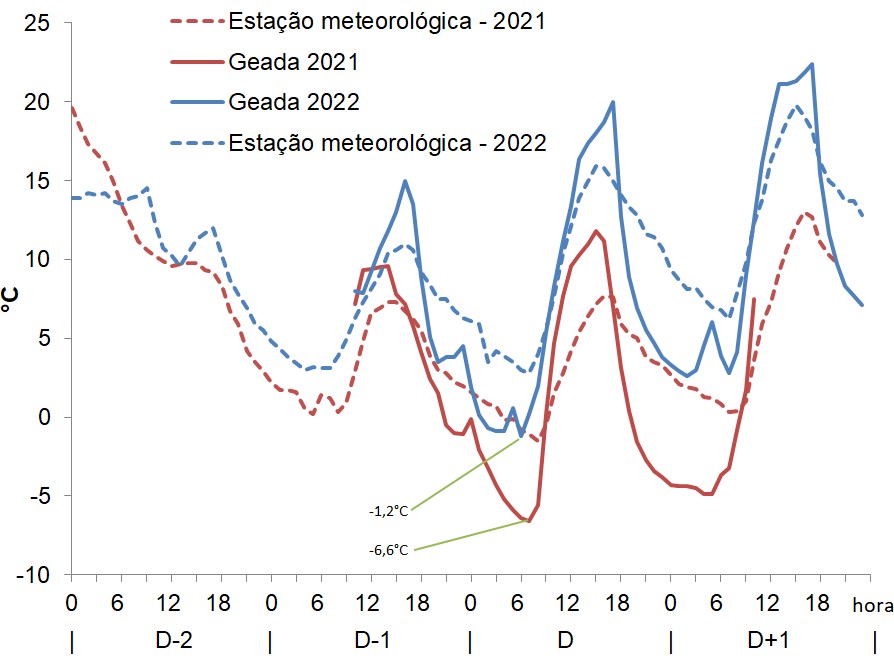Danos de geada em oliveiras jovens cv. Arbequina e Koroneiki tratadas com L-prolina, ácido salicílico ou bioestimulante
DOI:
https://doi.org/10.52945/rac.v36i3.1610Palavras-chave:
Olea europaea, frio, prolina, ácido salicílicoResumo
Oliveiras jovens podem ser perdidas por danos de geada em climas subtropicais, especialmente em áreas com
altitude elevada, onde o potencial de produção é maior. Assim, este trabalho teve por objetivo identificar tratamentos químicos que reduzam os danos de geada em plantas jovens, e comparar os cultivares Arbequina e Koroneiki quanto a sua resistência à geada. Foram realizados dois experimentos de campo em Chapecó, Santa Catarina: com plantas de oliveira dos cultivares ‘Koroneiki’ em 2021; e com ‘Arbequina’ e ‘Koroneiki’ em 2022. Três dias antes da geada prevista as plantas cultivadas em vasos foram aspergidas com L-prolina 10g L-1, o composto One. A Pro 15mL L-1, ácido salicílico 28 mg L-1 e um controle (água). A temperatura do ar atingiu -6,6 e -1,2°C, em 2021 e 2022, respectivamente, levando as plantas, em 2021, a queima
de brotações, fissuras no tronco, brotação intensa próxima ao colo (tronco) e morte, com aumento de extravasamento de eletrólitos celulares (EEC) nas folhas, inclusive em 2022. As aspersões não preveniram significativamente os danos, enquanto em 2022 a ‘Arbequina’ apresentou EEC significativamente menor. Conclui-se que ‘Arbequina’ tem menor EEC por geada e que as aspersões testadas não melhoram a capacidade das oliveiras de suportar o estresse por congelamento.
Referências
BONGI, G.; PALLIOTTI, A. Olive. In: SCHAFFER B.; ANDERSEN, P.C. (Eds). Handbook of Environmental Physiology of Fruit Crops: Temperate Crops. Boca Ratón: CRC press, 1994. p.165-188.
BRUGNARA, E.C.; KLOCK, A.L.S.; SABIÃO, R.R. Concentração de prolina em folhas de oliveira (Olea europaea L.) aspergidas com L-prolina e fertilizante foliar. In: FRUSUL - SIMPÓSIO DE FRUTICULTURA DA REGIÃO SUL, 3, 2022, On-line. Anais[...]. Disponível em: https://portaleventos.uffs.edu.br/index.php/FRUSUL/article/view/16231/12248. Acesso em: 05 abr. 2023.
DENNEY, J.O.; MARTIN, G.C.; KAMMERECK, R.;.KETCHIE, D.O.; CONNELL, J.H.; KRUEGER, W.H. OSGOOD, J.W.; SIBBETT, G.S.; NOUR, G.A. Freeze damage and cold hardiness in olive: findings from the 1990 freeze. California Agriculture, v.47, n.1, special section, p.1-12, 1993. Disponível em: https://calag.ucanr.edu/Archive/?article=ca.v047n01ps1. Acesso em: 12 jun. 2019.
EL-SAYED, O.M.; EL-GAMMAL, A.S.M. SALAMA. Effect of ascorbic acid, proline and jasmonic acid foliar spraying on fruit set and yield of Manzanillo olive trees under salt stress. Scientia horticulturae, v.176, p.32-37, 2014. Doi: https://doi.org/10.1016/j.scienta.2014.05.031.
DE SANGOSSE. ONE.A PRO – fertilizante foliar. Apresenta informações sobre o fertilizante foliar ONE.A.PRO. 2023. Disponível em: https://www.desangosse.com.br/nutricao-e-fisiologia/onea-pro-. Acesso em: 22 mar. 2023.
GALLOTTI, G.J.M.; DA CROCE, D.M. Observação do comportamento agronômico de cultivares de oliveira no Planalto Norte catarinense. Agropecuária Catarinense, v.25, n.2, p.49-52, 2012.
GÓMEZ-DEL-CAMPO, M.; BARRANCO, D. Field evaluation of frost tolerance in 10 olive cultivars. Plant Genetic Resources, v.3, n.3, p.385–390, 2005. Doi: https://doi.org/10.1079/PGR200592.
HASHEMPOUR, A.; GHASEMNEZHAD, M.; GHAZVINI, R.F.; SOHANI, M.M. The Physiological and Biochemical Responses to Freezing Stress of Olive Plants Treated with Salicylic Acid. Russian Journal of Plant Physiology, v.61, n.4, p.443–450, 2014. Doi: https://doi.org/10.1134/S1021443714040098.
HAYAT, S; ALYEMENI, M.N.; WANI, A.S.; PICHTEL, J.; AHMAD, A. Role of proline under changing environments - A review. Plant Signaling & Behavior, v.7, n.11, p.1456–1466, 2012. Doi: https://doi.org/10.4161/psb.21949.
INMET – Instituto Nacional de Meteorologia. Tabelas de dados das estações. Disponibiliza consulta a dados registrados nas estações meteorológicas. 2022. Disponível em: https://tempo.inmet.gov.br/. Acesso em: 30 ago. 2022.
NAVARRO GARCÍA, C.; MESQUITA, H.A.; ALVARENGA, A.A. Limitações de clima, solo e planejamento do plantio para o cultivo da oliveira. In.: OLIVEIRA, A.F. de (ed.). Oliveira no Brasil. Tecnologias de produção. Belo Horizonte: Epamig, 2012. p.349-383.
NAZAR, R.; UMAR, S.; KHAN, N.A.; SAREER, O. Salicylic acid supplementation improves photosynthesis and growth in mustard through changes in proline accumulation and ethylene formation under drought stress. South African Journal of Botany, v.98, p.84–94, 2015. Doi: https://doi.org/10.1016/j.sajb.2015.02.005.
PANDOLFO, C.; BRUGNARA, E. C.; RICCE, W. S.; VIANNA, L. F. N.; LEITE, G. B. Risco climático para oliveira em Santa Catarina. Agrometeoros, v. 29, n. 1, p. 1-14, 2021. Doi: https://doi.org/10.31062/agrom.v29.e026930.
POURY, N.; SEIFI, E.; ALIZADEH, M. Effects of Salinity and Proline On Growth and Physiological Characteristics of Three Olive Cultivars. Gesunde Pflanzen, 2022. Doi: https://doi. org/10.1007/s10343-022-00778-0.
R CORE TEAM. R: A language and environment for statistical computing. R Foundation for Statistical Computing, Vienna, Austria, 2022. Disponível em: https://www.R-project.org/. Acesso em: 16 mar. 2023.
SAADATI, S.; BANINASAB, B.; MOBLI, M.; GHOLAMI, M. Measurements of freezing tolerance and their relationship with some biochemical and physiological parameters in seven olive cultivars. Acta Physiologiae Plantarum, v.41, n.51, 2019. Doi: https://doi.org/10.1007/s11738-019-2843-8.
SNYDER, R.L.; DE MELO-ABREU, J.P.; Frost protection: fundamentals, practice and economics. Romae: Food and Agriculture Organization of the United Nations, 2005. 112p. v.1. Disponível em: http://home.isa.utl.pt/~jpabreu/Docs/FROST_Volume1.pdf . Acesso em: 12 jul. 2019.
VAN SWAAIJ, A.C.; JACOBSEN, E.; FEENSTRA, W.J. Effect of cold hardening, wilting and exogenously applied proline on leaf proline content and frost tolerance of several genotypes of Solanum. Phisiologia plantarum, v.64, n.2, p.230-236, 1985. Doi: https://doi.org/10.1111/j.1399-3054.1985.tb02341.x.
WREGE, M.S.; STEINMETZ, S.; REISSER JUNIOR, C.; ALMEIDA. I.R.; GARRASTAZU, M.C.; HERTER, F.G.; CARAMORI, P.H.; MATZENAUER, R.; RADIN. B.; BRAGA, H.J.; PANDOLFO, C.; PRESTES, S.D.; CUNHA, G.R.; MALUF, J.R.T. Atlas climático da Região Sul do Brasil: estados do Paraná, Santa Catarina e Rio Grande do Sul. Brasília: Embrapa, 2012. Disponível em: https://www.agricultura.rs.gov.br/upload/arquivos/202005/13110041-atlas-climatico-da-regiao-sul-do-brasil.pdf. Acesso em: 19 set. 2023.

Downloads
Publicado
Edição
Seção
Licença
Copyright (c) 2023 Eduardo Cesar Brugnara, Rafael Roveri Sabião

Este trabalho está licenciado sob uma licença Creative Commons Attribution 4.0 International License.





